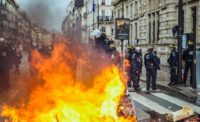College campuses have been the sight of a resurgence in peaceful protest, and some experienced shout down efforts and violent riots. Is there a way to plan for these incidents?
In a webinar, Maureen S. Rush, vice President for Public Safety and Superintendent of the Penn Police Department; Deputy Chief Michael Fink of the University of Pennsylvania Police Department; and Captain Gerald J. “Jerry” Leddy, Jr. with the University of Pennsylvania Police Department; discussed strategies and policies that assist a security team in preparing for the best and the worst of protests in the modern age.
The presenters discussed strategies to mitigate risk during protests, policies to assist a campus security team during a protest, and reviewed response and containment best practices of protests and civil disobediences on college campuses.
Captain Leddy discussed how the team develops an “Ops Orders” before the event that assists in the planning process. It includes:
- Event data and information
- Mission statement for event detail
- Staffing with specific responsibilities
- Chain of Command outlined
- Communications
- Partnerships
- Specific detail orders
- Event specific contact list with mobile numbers
- After-action report
The team also discussed how they were able to protect several high-profile speakers, such as Chelsea Manning, an American activist, politician, and former United States Army soldier; and Brother Ross, who preaches controversial Christianity. In addition to the University of Pennsylvania Police Department, the team works closely with the City of Philadelphia Police Department to protect their First Amendment Rights while also respecting the security needs of University students, faculty and staff.
Overall, the speakers recommend that security professionals who are securing a planned and unplanned protest should:
- Expect the unexpected
- Evaluate policies and procedures
- Evaluate command and control, including communications procedures
- Identify potential campus protest scenarios: What are your standing themes and issues?
- Identify resources needed vs. available
- Create an action plan to address identified needs, including training
- Extend internal exercise to include university partners
- Be organized
- Document, document, document









